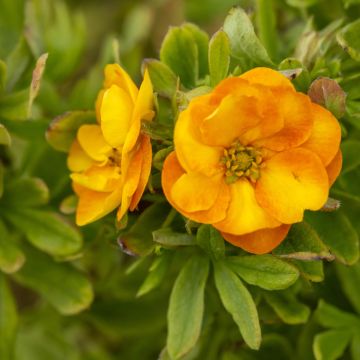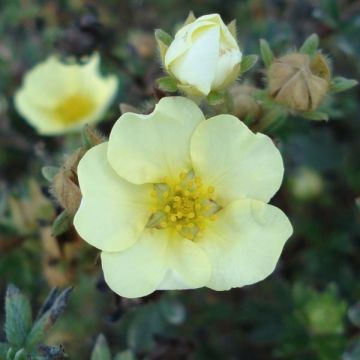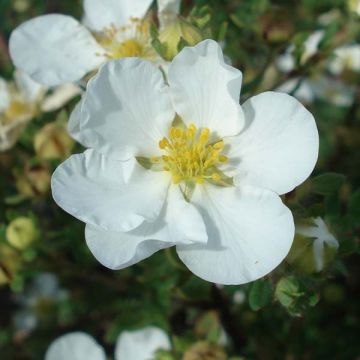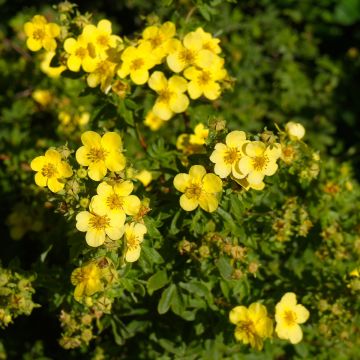

Potentilla fruticosa Elizabeth (= Sutters gold)
Potentilla fruticosa Elizabeth (= Sutters gold)
Potentilla fruticosa Elizabeth (= Sutters gold)
Potentille arbustive, Potentille frutescente, Quintefeuille en arbre
This item cannot be shipped to the selected country
Delivery charge from €5.90
Delivery charge from €5.90
Delivery charge from €5.90
More information
Delivery charge from €5.90
Delivery charge from €5.90
Delivery charge from €5.90
More information
Schedule delivery date,
and select date in basket
This plant carries a 24 months recovery warranty
More information
We guarantee the quality of our plants for a full growing cycle, and will replace at our expense any plant that fails to recover under normal climatic and planting conditions.
From €5.90 for pickup delivery and €6.90 for home delivery
Express home delivery from €8.90.
From €5.90 for pickup delivery and €6.90 for home delivery
Express home delivery from €8.90.
From €5.90 for pickup delivery and €6.90 for home delivery
Express home delivery from €8.90.

Does this plant fit my garden?
Set up your Plantfit profile →
Description
The Potentilla fruticosa Elisabeth (synonym Sutters Gold) is a timeless variety of shrubby potentilla that is unmatched in its floribundity and the vibrant colour of its small yellow flowers. They bloom abundantly and for months, from late spring to late summer, on a well-bushed and nicely rounded bush, highlighted by finely cut foliage of a beautiful bright green. Easy to grow, hardy, requiring little maintenance, the shrubby potentilla fits everywhere, in flower beds but also in large pots on the terrace. It is a most rewarding plant, and almost foolproof in well-drained soil.
The Potentilla fruticosa is a woody shrub that belongs to the Rosaceae family. The 'Elisabeth' variety was obtained in 1950 by Hiller nurseries in Great Britain. The plant has a bushy, regular and rounded habit and a dense growth. At maturity, it will measure approximately 1 m (3 ft 4 in) in all directions. Its slender and ramified branches, brown in colour, peeling with age, bear deciduous foliage, which falls in autumn. The small size of the leaves, cut into narrow leaflets, gives a beautiful lightness to the silhouette of a bright green. A light white hairiness on the underside of the leaves gives a silky and slightly silver aspect to the foliage. Its delicate flowers are cup-shaped and 3 cm (1.2 in) in diameter, with five golden yellow petals surrounding a small orange throat. Under the effect of the sun, the color fades, creating a range of yellow on the shrub. The abundant flowering, starting in May and lasting until the arrival of autumn, is generally more intense in early summer, then loses some of its vigor during the season, depending on the freshness of the soil.
In full sun, the potentillas will deliver flowers with more vibrant colours, in partial shade, the color will be slightly less vivid but the flowering will be longer. Carefree plants, generously floriferous and pleasantly colored, potentillas are ideal for brightening up the garden or balcony, sustainably and effortlessly. With their Scottish rose-like appearance and their very modest requirements, they can be used in multiple ways and installed anywhere; in flower beds, rockeries, borders, low hedges, containers. In most climates and in any well-drained soil.
Potentilla fruticosa Elizabeth (= Sutters gold) in pictures




Plant habit
Flowering
Foliage
Botanical data
Potentilla
fruticosa
Elizabeth (= Sutters gold)
Rosaceae
Potentille arbustive, Potentille frutescente, Quintefeuille en arbre
Cultivar or hybrid
Other Potentilla - Cinquefoils
Planting and care
Very easy to grow, the Potentilla fruticosa 'Elisabeth' is hardy and tolerates low negative temperatures (-20 °C). It prefers a sunny or partially shady exposure. Its only real requirement concerns the nature of the soil where it is planted. Indeed, it requires ordinary, rather poor soil, and very well-drained. In case of heavy or clayey soils that are not suitable, it should be placed on a slope or a rockery to promote water drainage. It is also possible to lighten the soil at the time of planting by adding coarse sand and gravel to obtain better drainage. An additional quality to be added to its list of achievements is its good tolerance to drought once established.
The shrubby potentilla does not require much maintenance. Blooming on the shoots of the year, a simple annual pruning of refreshing is necessary. It is recommended to cut back by half the stems that have borne the flowers of the previous year, just above a bud, in early spring, in order to stimulate regrowth and maintain the beautifully bushy shape of your potentilla. It is also desirable to remove faded flowers as they appear during flowering, to prolong it for a long time.
Planting period
Intended location
Care
-
, onOrder confirmed
Reply from on Promesse de fleurs
Haven't found what you were looking for?
Hardiness is the lowest winter temperature a plant can endure without suffering serious damage or even dying. However, hardiness is affected by location (a sheltered area, such as a patio), protection (winter cover) and soil type (hardiness is improved by well-drained soil).

Photo Sharing Terms & Conditions
In order to encourage gardeners to interact and share their experiences, Promesse de fleurs offers various media enabling content to be uploaded onto its Site - in particular via the ‘Photo sharing’ module.
The User agrees to refrain from:
- Posting any content that is illegal, prejudicial, insulting, racist, inciteful to hatred, revisionist, contrary to public decency, that infringes on privacy or on the privacy rights of third parties, in particular the publicity rights of persons and goods, intellectual property rights, or the right to privacy.
- Submitting content on behalf of a third party;
- Impersonate the identity of a third party and/or publish any personal information about a third party;
In general, the User undertakes to refrain from any unethical behaviour.
All Content (in particular text, comments, files, images, photos, videos, creative works, etc.), which may be subject to property or intellectual property rights, image or other private rights, shall remain the property of the User, subject to the limited rights granted by the terms of the licence granted by Promesse de fleurs as stated below. Users are at liberty to publish or not to publish such Content on the Site, notably via the ‘Photo Sharing’ facility, and accept that this Content shall be made public and freely accessible, notably on the Internet.
Users further acknowledge, undertake to have ,and guarantee that they hold all necessary rights and permissions to publish such material on the Site, in particular with regard to the legislation in force pertaining to any privacy, property, intellectual property, image, or contractual rights, or rights of any other nature. By publishing such Content on the Site, Users acknowledge accepting full liability as publishers of the Content within the meaning of the law, and grant Promesse de fleurs, free of charge, an inclusive, worldwide licence for the said Content for the entire duration of its publication, including all reproduction, representation, up/downloading, displaying, performing, transmission, and storage rights.
Users also grant permission for their name to be linked to the Content and accept that this link may not always be made available.
By engaging in posting material, Users consent to their Content becoming automatically accessible on the Internet, in particular on other sites and/or blogs and/or web pages of the Promesse de fleurs site, including in particular social pages and the Promesse de fleurs catalogue.
Users may secure the removal of entrusted content free of charge by issuing a simple request via our contact form.













































